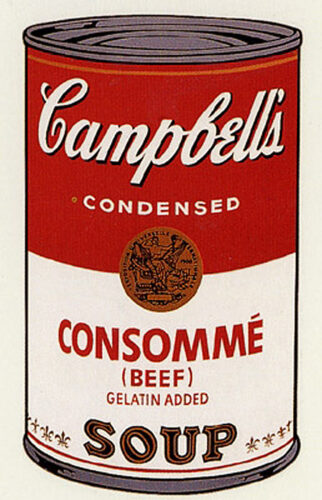
Campbell’s, the iconic brand that Andy Warhol memorialized, recently reported that their quarterly sales fell to $2.23 billion, a 2 percent drop from the same quarter last year, and that earnings per share fell to 66 cents, down 11 percent [1]. Further, as my charts below show, Campbell’s has about the same level of annual revenue today as it had 20 years ago.
What happened? Why have they not effectively grown in 20 years?
First, obviously, the company has certainly not failed – and $2+ billion in revenue in a quarter is not shabby. They are also still profitable. Second, they have bought and sold divisions (more on that below) and that alone has added *and* subtracted revenues independent of consumer demand.
But, importantly, like many companies they are having a hard time responding to customer change.
The CEO, Denise Morrison, recently said at an industry conference that they know big changes are afoot with customers – “We are well aware of the consumer distrust of Big Food.” [1]
I don’t doubt that they are aware – but what seems clear is that they have not been *acting* on that knowledge.
I start each of my Customers Included talks these days with this simple admission: I am not the first person to talk about the importance of the customer. In fact, many writers, business leaders, consultants, and others have talked about the importance of the customer for decades.
Yet – as I point out in my talks – most companies still produce mediocre products and services.
Why?
While most companies “know” the customer is important – and most companies even know something about what matters to their customers, most companies stop there. They seem unable to make significant changes.
Early signs of the change in consumer behavior away from “Big Food” to organic and natural foods were first evident in the early 1990s when Whole Foods first went public (data in above chart supplied by Whole Foods through its annual reports). Arguably, Whole Foods’ meteoric revenue growth since then has served as a long-term proxy for the growth of organic foods in general.
What has Campbell Soup Company done in response to this?
Here is a chart of Campbell Soup revenues (red bars) compared to Whole Foods revenues (blue bars) from 1995 to today. They’ve gone down a bit, up a bit. They’ve restructured. They’ve sold divisions. They even purchased a few small health food companies.
They have increased earnings per share (a key metric for investors) and they have terrific return-on-equity numbers. These are both very strong indicators of health. Yet – they seem stuck between their commitment to their 20th century brand and their smaller commitment to health food.
Perhaps, to their defense, it was hard for Campbell’s to tell in the 1990s what was happening. Whole Foods was so small – who knew if this health food trend would last?
But, what were they thinking in 2008 when Whole Foods now had revenues equal to their own?
A review of their annual reports going back to the 1990s show little evidence of serious strategic work to reexamine core assumptions and deal directly and strategically with the growing organic and natural food movement.
For most of my 20+ years working on customer experience strategy, I have seen clearly that most executives are like those at Campbell’s: they seem to prefer internal realignments, M&A – really anything – to the hard work of making fundamental changes based on changing behaviors of customers.
Forget about ancient history, what are they thinking now?
Now they must be acting on the undeniable trend away from “Big Food” that their CEO so eloquently acknowledged?
They must be getting closer to their customers – no matter how painful or difficult that might be? Right?
No.
Their CEO instead announced they are going to launch a “start-from-scratch accounting approach called zero-based budgeting that requires departments to justify spending anew every year.” [2]
To her credit, her statement also included something about customers and making the company more agile but the emphasis seems clearly on launching this new accounting system.
And that sadly seems a bit like the same old canned response.
– Phil
—-
[Footnotes]
[1] Campbell Soup Posts Drop in Revenue and Earnings
The New York Times
FEB. 25, 2015
http://www.nytimes.com/2015/02/26/business/campbell-soup-2q-results.html
[2] Campbell Soup Outlines Aggressive Cost Cuts, Reorganization
The Wall Street Journal
Feb 18, 2015
http://www.wsj.com/articles/campbell-soup-to-unveil-cost-cutting-plan-1424268625
Organic Food Sales on the Rise
Time Magazine
May 13, 2014
http://time.com/97949/organic-food-sales-on-the-rise/